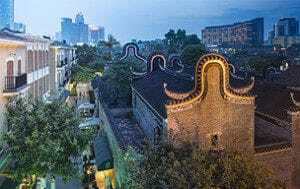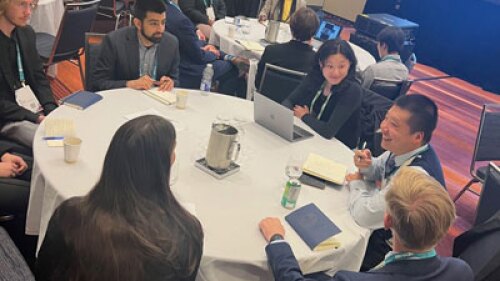With 7 million people, the Chinese city of Foshan could hardly be considered insignificant. But because it is located in the Pearl River Delta—China’s largest urbanized area, accounting for 20 percent of the country’s gross domestic product (GDP)—Foshan must work hard to set itself apart from other major cities in the megaregion, such as Hong Kong, Guangzhou, and Shenzhen.
All the cities in the Pearl River Delta are vying to be destinations for China’s rapidly expanding middle class. But the economic forces that determined Foshan’s past are not what will shape its future. In the 1980s and 1990s, the city became the center of furniture manufacturing and the production of household electrical appliances, tools, and ceramics. Since 2000, value-added manufacturing and financial back-office outsourcing firms have also flourished.
Yet, as wages rise and the standard of living improves across China, Foshan risks seeing companies in these labor- and capital-intensive industries relocate to smaller inland Chinese cities or Southeast Asia where labor and capital costs are lower. College graduates, too, are less likely to seek opportunities in Foshan, choosing to live in a tier-one city like Shenzhen or move overseas.
Given these circumstances, how can Foshan’s economy continue to evolve and climb the value chain? And more important, how can civic and business leaders create unique and authentic urban environments with the requisite amenities sought by a young, educated workforce?
These were the questions that brought a ULI Advisory Services panel to Foshan in November at the request of the municipal government and Shui On Land, a private real estate firm developing a new mixed-use district in Foshan’s city center. The panel, a multidisciplinary group composed of global land use experts, was asked to develop recommendations that can help Foshan reposition its economy, revitalize its urban core, and craft a unique brand that marries innovation with the city’s historic past.
“Businesses Will Follow Talent”
As it moves from an economy based on manufacturing to one based on services, China is eager to show the world that it is not merely a factory for goods, but instead a designer and inventor of those goods as well. Innovation and a focus on knowledge-based industries must be the guiding principles of Foshan’s new economy, the panel said.
Entrepreneurship, too, should continue to be a focus for Foshan, as it has been in the past. The panel gave credit to Foshan’s business-friendly culture, citing several top manufacturing firms, including Midea Group, that call the city home.
“There seems to be some real energy emerging in Foshan, with talented entrepreneurs focused less on random high-tech ideas, but tech as it relates to the city’s historic roots in furniture manufacturing, appliance design—refrigerators, air-conditioning units, washers, and dryers—and auto parts,” said panelist Allen Folks, vice president for design, planning, and economics for Southeast Asia at AECOM.
Yet officials are also worried about losing homegrown entrepreneurs, particularly people with new and cutting-edge ideas, said panel chair Tom Murphy, former mayor of Pittsburgh and ULI senior resident fellow.
Murphy cited the example of a 20-something entrepreneur, a Foshan native educated in Canada who was interviewed by the panelists as part of their research. The entrepreneur had developed a chip technology to monitor the energy consumption of household appliances—a perfect blend of Foshan’s manufacturing past and tech-oriented future. Yet, he is unsure about keeping his company in Foshan because of its lack of the nightlife, retailers, and recreational amenities that would attract and retain white-collar workers.
In a newspaper column about her experience on the Foshan panel, urban planner Karima Palafox said Foshan’s future will not be determined by the number of goods produced or the pace at which it can build skyscrapers and roads, but by noneconomic factors: a clean natural environment, high-quality health care, cultural amenities, and other livability factors.
“Despite the high income and the presence of first-class infrastructure, the city has been threatened by out-migration of its people,” wrote Palafox, a partner at the Manila-based Palafox Associates. “Previously people went to where the jobs were. In the knowledge economy, businesses will follow the talent. The cities that will win the fight for talent will be those that provide the highest quality of life.”
Part of that quality of life entails creating a strong “cradle-to-grave” education system, Palafox wrote. The current system in Foshan is perceived as being weak at the primary, secondary, and postsecondary levels. Established in 1995, Foshan University has yet to distinguish itself, placing near the bottom of several Chinese university rankings in terms of scholastics and quality.
A few Western universities have reached out to local institutions, which is a promising sign. Carnegie Mellon University has established the Joint Institute of Engineering with the Shunde district government in Foshan and Sun Yat-Sen University in Guangzhou. But more could be done to attract a world-class university to Foshan and strengthen ties between universities and the private sector, panelists said.
Another way Foshan could solve its human capital problem is if the hukou, or resident registration system, is reformed, several panelists observed. Migrants from rural towns within China account for about 50 percent of Foshan’s population, yet according to the hukou system, they are ineligible for residency permits and barred from the city’s public schools, housing, and health and social welfare benefits. While reforms would have to come from the central government in Beijing, they would be necessary for Foshan to fully invest in and reap the benefits of these newcomers, the panel said.
Directing Investment Back to the Urban Core
Composed of five districts, Foshan has a development pattern that echoes those that dominated American cities until recently—the growth of suburban office and industrial parks and housing developments away from city centers. This trend has lead to sprawl and inefficient land use patterns.
In Foshan, the suburban districts of Nanhai and Shunde have experienced the lion’s share of investment as sites of special economic zones established by the government to attract foreign companies. These zones include the Sino-German Industrial Zone and Guangdong Industrial Design City in Shunde, and the Guangdong Financial High-Tech Industrial Development Zone in Nanhai.
Yet these suburban district governments are nervous about a worldwide trend in business to which China is not immune—the return of companies to downtowns. These suburban economic zones could soon face struggles with recruitment because they offer little in terms of amenities, authenticity, or a sense of place. Companies are already contending with labor shortages.
The Nanhai district government, in fact, developed the Thousand Lantern Lake Park System to create a distinctive attraction amid a series of impersonal office towers and government buildings. Co-recipient of the 2015 ULI Urban Open Space Award, the park is a 286-acre (116 ha) green corridor that connects Nanhai’s commercial district with public plazas and a series of lakes and waterways.
Both panel members and sponsors expressed concern that low-density suburban development in Nanhai and Shunde has occurred at the expense of Chancheng, Foshan’s central district, or urban core. Known for its intricately carved rooftops and archways, dense urban form, and Buddhist temples, Chancheng is a historic city that has lost much of its former vitality, which both the public and private sectors want to restore.
Panelist Lee In-Keun, president of the Land and Housing Institute at the Korea Land and Housing Corporation, noted that building efficient transportation networks outward from Chancheng will reduce travel times between Foshan and the regional airport and other cities in the Pearl River Delta. These networks can help strengthen Chancheng’s central business district and it connections to cities within the delta.
“You can have peripheral growth, but it should be linked to policies that emanate from the core and what makes this region special,” Folks said.
The Foshan Brand: Historic Sites and Ancient Culture
In recent years, China has placed a greater emphasis on historic preservation, a trend that runs counter to the demolition and new construction boom that occurred in the rush toward modernization after 1980.
For its part, Shanghai-based Shui On Land, led by Chairman and ULI Member Vincent Lo, is playing a key role in revitalizing Chancheng and rebranding Foshan as the cradle of Lingnan culture, a premodern artistic and cultural movement that blended Southeast Asian and Cantonese influences.
Having completed the successful Xintiandi project in Shanghai, Shui On Land has been commissioned to build a similar luxury mixed-use district with boutique retail businesses and entertainment as its anchors. Lingnan Tiandi takes advantage of Chancheng’s stone-and-brick buildings, courtyards, and alleyways through the adaptive use of 19th-century merchant housing and the period street grid.
Articulating what makes Foshan special, the panel recommended development of a tourism infrastructure around Chancheng’s historic and religious sites. Wayfinding, walkability between historic sites and new developments, a visitor center, and a full calendar of cultural events and entertainment could all be part of a robust tourism and rebranding campaign, the panel said.
The panel praised Chancheng for what it has that Shunde and Nanhai do not: authenticity, indigenous culture, and urban grit, the characteristics toward which innovators, artists, and the creative class gravitate. Live/work housing, affordable housing geared toward students, and artist lofts could all be promising investments in Chancheng’s historic building stock, the panel said.
Now the challenge for leaders in Foshan is how to blend the old with the new so that Foshan stands out in the minds of young Chinese professionals who are as educated and mobile as their counterparts in Europe and the United States and can choose where to build their lives.
“The government has neglected the primary essence of what makes this place so special,” Folks said. “It is the center of one of China’s ancient civilizations and is fabulously wealthy in terms of culture. Foshan is the largest city in the world with so much history that no one has ever heard of. To not tell that story and celebrate it as an economic strategy for success is a missed opportunity.”




